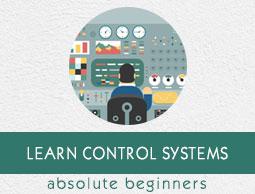Control Systems - State Space Analysis
In the previous chapter, we learnt how to obtain the state space model from differential equation and transfer function. In this chapter, let us discuss how to obtain transfer function from the state space model.
Transfer Function from State Space Model
We know the state space model of a Linear Time-Invariant (LTI) system is -
$$\dot{X}=AX+BU$$
$$Y=CX+DU$$
Apply Laplace Transform on both sides of the state equation.
$$sX(s)=AX(s)+BU(s)$$
$$\Rightarrow (sI-A)X(s)=BU(s)$$
$$\Rightarrow X(s)=(sI-A)^{-1}BU(s)$$
Apply Laplace Transform on both sides of the output equation.
$$Y(s)=CX(s)+DU(s)$$
Substitute, X(s) value in the above equation.
$$\Rightarrow Y(s)=C(sI-A)^{-1}BU(s)+DU(s)$$
$$\Rightarrow Y(s)=[C(sI-A)^{-1}B+D]U(s)$$
$$\Rightarrow \frac{Y(s)}{U(s)}=C(sI-A)^{-1}B+D$$
The above equation represents the transfer function of the system. So, we can calculate the transfer function of the system by using this formula for the system represented in the state space model.
Note − When $D = [0]$, the transfer function will be
$$\frac{Y(s)}{U(s)}=C(sI-A)^{-1}B$$
Example
Let us calculate the transfer function of the system represented in the state space model as,
$$\dot{X}=\begin{bmatrix}\dot{x}_1 \\\dot{x}_2 \end{bmatrix}=\begin{bmatrix}-1 & -1 \\1 & 0 \end{bmatrix}\begin{bmatrix}x_1 \\x_2 \end{bmatrix}+\begin{bmatrix}1 \\0 \end{bmatrix}[u]$$
$$Y=\begin{bmatrix}0 & 1 \end{bmatrix}\begin{bmatrix}x_1 \\x_2 \end{bmatrix}$$
Here,
$$A=\begin{bmatrix}-1 & -1 \\1 & 0 \end{bmatrix}, \quad B=\begin{bmatrix}1 \\0 \end{bmatrix}, \quad C=\begin{bmatrix}0 & 1 \end{bmatrix} \quad and \quad D=[0]$$
The formula for the transfer function when $D = [0]$ is -
$$\frac{Y(s)}{U(s)}=C(sI-A)^{-1}B$$
Substitute, A, B & C matrices in the above equation.
$$\frac{Y(s)}{U(s)}=\begin{bmatrix}0 & 1 \end{bmatrix}\begin{bmatrix}s+1 & 1 \\-1 & s \end{bmatrix}^{-1}\begin{bmatrix}1 \\0 \end{bmatrix}$$
$$\Rightarrow \frac{Y(s)}{U(s)}=\begin{bmatrix}0 & 1 \end{bmatrix} \frac{\begin{bmatrix}s & -1 \\1 & s+1 \end{bmatrix}}{(s+1)s-1(-1)}\begin{bmatrix}1 \\0 \end{bmatrix}$$
$$\Rightarrow \frac{Y(s)}{U(s)}=\frac{\begin{bmatrix}0 & 1 \end{bmatrix}\begin{bmatrix}s \\1 \end{bmatrix}}{s^2+s+1}=\frac{1}{s^2+s+1}$$
Therefore, the transfer function of the system for the given state space model is
$$\frac{Y(s)}{U(s)}=\frac{1}{s^2+s+1}$$
State Transition Matrix and its Properties
If the system is having initial conditions, then it will produce an output. Since, this output is present even in the absence of input, it is called zero input response $x_{ZIR}(t)$. Mathematically, we can write it as,
$$x_{ZIR}(t)=e^{At}X(0)=L^{-1}\left \{ \left [ sI-A \right ]^{-1}X(0) \right \}$$
From the above relation, we can write the state transition matrix $\phi(t)$ as
$$\phi(t)=e^{At}=L^{-1}[sI-A]^{-1}$$
So, the zero input response can be obtained by multiplying the state transition matrix $\phi(t)$ with the initial conditions matrix.
Following are the properties of the state transition matrix.
If $t = 0$, then state transition matrix will be equal to an Identity matrix.
$$\phi(0) = I$$
Inverse of state transition matrix will be same as that of state transition matrix just by replcing ‘t’ by ‘-t’.
$$\phi^{-1}(t) = \phi(−t)$$
If $t = t_1 + t_2$ , then the corresponding state transition matrix is equal to the multiplication of the two state transition matrices at $t = t_1$ and $t = t_2$.
$$\phi(t_1 + t_2) = \phi(t_1) \phi(t_2)$$
Controllability and Observability
Let us now discuss controllability and observability of control system one by one.
Controllability
A control system is said to be controllable if the initial states of the control system are transferred (changed) to some other desired states by a controlled input in finite duration of time.
We can check the controllability of a control system by using Kalman’s test.
Write the matrix $Q_c$ in the following form.
$$Q_c=\left [ B \quad AB \quad A^2B \quad ...\quad A^{n-1}B \right ]$$
Find the determinant of matrix $Q_c$ and if it is not equal to zero, then the control system is controllable.
Observability
A control system is said to be observable if it is able to determine the initial states of the control system by observing the outputs in finite duration of time.
We can check the observability of a control system by using Kalman’s test.
Write the matrix $Q_o$ in following form.
$$Q_o=\left [ C^T \quad A^TC^T \quad (A^T)^2C^T \quad ...\quad (A^T)^{n-1}C^T \right ]$$
Find the determinant of matrix $Q_o$ and if it is not equal to zero, then the control system is observable.
Example
Let us verify the controllability and observability of a control system which is represented in the state space model as,
$$\dot{x}=\begin{bmatrix}\dot{x}_1 \\\dot{x}_2 \end{bmatrix}=\begin{bmatrix}-1 & -1 \\1 & 0 \end{bmatrix}\begin{bmatrix}x_1 \\x_2 \end{bmatrix}+\begin{bmatrix}1 \\0 \end{bmatrix} [u]$$
$$Y=\begin{bmatrix}0 & 1 \end{bmatrix}\begin{bmatrix}x_1 \\x_2 \end{bmatrix}$$
Here,
$$A=\begin{bmatrix}-1 & -1 \\1 & 0 \end{bmatrix}, \quad B=\begin{bmatrix}1 \\0 \end{bmatrix}, \quad \begin{bmatrix}0 & 1 \end{bmatrix}, D=[0]\quad and \quad n=2$$
For $n = 2$, the matrix $Q_c$ will be
$$Q_c=\left [B \quad AB \right ]$$
We will get the product of matrices A and B as,
$$AB=\begin{bmatrix}-1 \\1 \end{bmatrix}$$
$$\Rightarrow Q_c =\begin{bmatrix}1 & -1 \\0 & 1 \end{bmatrix}$$
$$|Q_c|=1 \neq 0$$
Since the determinant of matrix $Q_c$ is not equal to zero, the given control system is controllable.
For $n = 2$, the matrix $Q_o$ will be -
$$Q_o=\left [C^T \quad A^TC^T \right ]$$
Here,
$$A^T=\begin{bmatrix}-1 & 1 \\-1 & 0 \end{bmatrix} \quad and \quad C^T=\begin{bmatrix}0 \\1 \end{bmatrix}$$
We will get the product of matrices $A^T$ and $C^T$ as
$$A^TC^T=\begin{bmatrix}1 \\0 \end{bmatrix}$$
$$\Rightarrow Q_o=\begin{bmatrix}0 & 1 \\1 & 0 \end{bmatrix}$$
$$\Rightarrow |Q_o|=-1 \quad \neq 0$$
Since, the determinant of matrix $Q_o$ is not equal to zero, the given control system is observable.
Therefore, the given control system is both controllable and observable.



